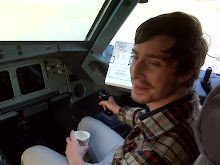
There are some preconceived notions about ambient music. One of them being that the listener must devote a significant amount of time to enjoy it. Another being that an ambient composition must be experienced in its entirety in order to be properly appreciated.
I am not in disagreement with either of these presumptions.
However, this is not a work of ambient music.
Music For Real Airports utilizes its title as a send-up of Eno's early classic, but the core ingredients are ideologically different. The eras that separate the two albums have also contributed fundamentally to the marked divergence, both in terms of the modernization of music and of airports.
The Black Dog might have more aptly titled this Music For Airports: A 20th Century Sequel, since it seems to take on the anxieties and the sublime spaciousness that air-travel has come to symbolize over the past ten years.
It's almost as though The Black Dog were hired as architects to renovate the already remarkable 1978 Eno original. The way a major airport is renovated. Existing in the same space, with the same runways, and a redeveloped terminal, which holds the same echoes.
I am not in disagreement with either of these presumptions.
However, this is not a work of ambient music.
Music For Real Airports utilizes its title as a send-up of Eno's early classic, but the core ingredients are ideologically different. The eras that separate the two albums have also contributed fundamentally to the marked divergence, both in terms of the modernization of music and of airports.
The Black Dog might have more aptly titled this Music For Airports: A 20th Century Sequel, since it seems to take on the anxieties and the sublime spaciousness that air-travel has come to symbolize over the past ten years.
It's almost as though The Black Dog were hired as architects to renovate the already remarkable 1978 Eno original. The way a major airport is renovated. Existing in the same space, with the same runways, and a redeveloped terminal, which holds the same echoes.



